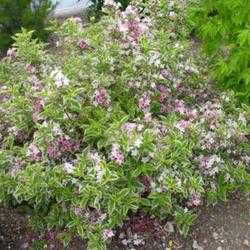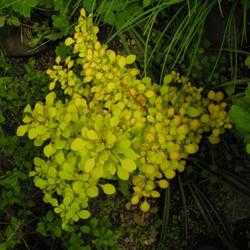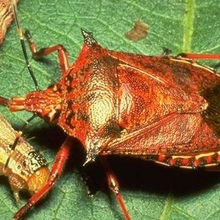(Editor's Note: This article was originally published on July 26, 2008. Your comments are welcome, but please be aware that authors of previously published articles may not be able to promptly respond to new questions or comments.)
Most gardeners are familiar with elderberries, whether as a source for fruit or as ornamentals. Growing up in Newfoundland, gardening was not a particularly common hobby (unlike today!) But even in the relatively out-of-the-world place where I live, golden elders were among the most popular garden ornamentals. It helped that breaking off a branch and sticking it in the ground would often result in a new plant, thus this shrub quickly spread from garden to garden. Forty years ago, shrubs with colourful summer leaves were not that commonly seen compared to today. Current trends in the plant breeding world are for more colourful foliage; variegated, yellow and purple-red leaves are top sellers. Delicately cut foliage which lend a graceful, fine-textured look are also popular. Well, as it should happen, the lowly elderberry has been right up there with these popular trends and in fact, it is probably a more popular shrub today than it was years ago.
Elderberries belong to the genus Sambucus. There are about 25 species worldwide but from an ornamental point-of-view, we are concerned with just three species: the European or black elderberry (S. nigra), American elderberry (S. canadensis...shouldn't it be the Canadian elderberry?) and the red elderberry (S. racemosa). It should be noted that the latest taxonomic work now considers the American red elderberry, S. pubens, as being a variety of S. racemosa while S. canadensis is now considered a subspecies of S. nigra. However, since the nursery trade still considers them seperate species, I'll do likewise.
Let's start with the wild species. The black elderberry (zone 4) and American elderberry (zone 3) appear very similar (hence their now being taxonomically lumped together). Both have large, compound leaves; those of S. nigra commonly have 5 leaflets while those of S. canadensis typically have 7, but that difference is not definitive. Both have flat-clusters of tiny white flowers followed by clusters of small, black fruit in autumn. The flower heads of S. nigra are quite flat while those of S. canadensis are slightly rounded on the top. The flowering season of S. nigra is several weeks earlier than that of S. canadensis. Finally, S. nigra is a larger sized, non-suckering shrub reaching 6 m, while S. canadensis is commonly suckering in habit, growing 3-4 m tall.




The wild species illustrated above are S. nigra (flower and fruit) and S. racemosa (flower and fruit); S. canadensis is essentially the same as S. nigra in regards to flower and fruit
The red elderberry (zone 3) occurs across Eurasia and North America. This elderberry will reach 3-4 m with 5-7 leaflet, compound leaves. They have conical, yellow-green to creamy flowers quite early in the season followed but clusters of small, bright red fruit in mid-summer.
Now for the cultivars. There are about 40 cultivars of S. nigra, selected primarily for their foliage, flowers or habit. Traditionally, the most popular cultivar of S. nigra was the yellow-foliaged selection called ‘Aurea'. Another old cultivar is ‘Pulverulenta' whose leaves are spotted, streaked and blotched white on green. ‘Marginata' (aka ‘Albo-variegata') has white-edged leaves while ‘Madonna' and 'Aureo-marginata' have yellow-edged foliage. Selections based on their flowers include ‘Plena', sterile with fully double flowers; ‘Roseiflora' with pink flowers and ‘Roseiplena' with sterile, double pink flowers. ‘Pendula' is an attractive weeping selection while ‘Pyramidalis' has a fastigiate habit. ‘Pygmy' and ‘Witch's Broom' are dwarf selections maturing at 60 cm and 45 cm respectively.




Some variegated selections of S. nigra include 'Madonna', 'Aureo-marginata', 'Pulverulenta' and 'Argenteo-marginata'
It was the lacy, cut-leaved form, ‘Laciniata' and the purple-leaved ‘Purpurea' that really stirred the gardening world. From ‘Laciniata' came ‘Dart's Greenlace', a particularly finely-cut selection that is almost like a dissectum-leaf Japanese maple. From ‘Purpurea' came ‘Guincho Purple' with darker purple foliage and then ‘Gerda' (aka Black Beauty), released in the US in 2004, with very dark purple-black leaves. All of these purple-leaved selections have pink flowers. And most recently (released in 2006) has come the best of both worlds, ‘Eva' (aka Black Lace) with lacy-cut, purple-black leaves, another substitute for a Japanese maple in colder regions.




Perhaps the most spectacular cultivars developed in recent years is 'Black Beauty' and 'Black Lace'
Most of the 15 or so selections of S. canadensis have been chosen for their fruit production. The exceptions are ‘Aurea', a yellow-leaved selection virtually identical to S. nigra ‘Aurea', ‘Argentomarginata' with white-edged leaves and ‘Laciniata' with cut-leaves.
There has been a fair amount of selecting occurring with S. racemosa as well, all stemming from the old selections ‘Aurea' , with yellow leaves, and ‘Laciniata', with lacy-cut leaves (do you see a similar trend to S. nigra?). From ‘Laciniata' came ‘Moerheimii' with even more finely cut foliage, then ‘Plumosa' whose feathery-foliage first emerges purple until most recently has come ‘Tenuifolia' whose leaves are ribbon-like, an excellent substitute for a Linearilobum Japanese maple in colder climates. The yellow-leaved form of ‘Plumosa' was named ‘Plumosa Aurea' and that selection has more recently given rise to ‘Sutherland Gold', a more sun-resistant selection, and ‘Goldenlocks', a dwarf form maturing at 1 m.


Some details of 'Sutherland Gold' and 'Golden Locks'
All elderberries grow best in full sun and moderately moist soil. The yellow-leaved forms will turn chartreuse in shadier sites and the purple-leaved forms will turn greenish-purple. If the soil is too dry, browning can occur along the leaf margins. The most serious pest is elderberry borer beetle ( a long-horned beetle that is metallic dark blue with a central orange band), whose larvae burrow up through the center of the stems causing death of that particular stem. If suspected, prune and burn the stems to kill the larvae. All elderberries can be trimmed to keep them smaller than their ultimate size would suggest. In fact, I regularly prune older stems to encourage new ones which often have larger leaves and better foliage colour. Under extreme situations, you can coppice them (remove all stems back to 15 cm) to completely rejuvenate a plant. When pruned in this manner, the resulting foliage can be super-sized!
So give elderberries a second look and see where in your landscape you can utilize these wonderful foliage shrubs.
I have many people to thank for the photos used in this article: daryl ('Golden Locks'); equilibrium ('Pulverulenta'); frostweed (blossoms of S. nigra); Gabrielle (opening photo); growin ('Aureo-marginata'); irmaly ('Sutherland Gold'); Jeff_Beck (fruit of S. nigra); KevinMc79 ('Madonna'); lunavox ('Argentio-maginata'); stevenova ('Black Beauty' flower and foliage, 'Black Lace' flower) and rcn48 ('Black Lace' foliage). Thanks everyone!

















